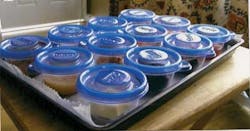The connection between diet and enamel erosion
by Alicia Almeida, RDH; Heidi Emmerling, RDH, PhD; Lauren McGreanor, RDA, RDH; Ashley Mitchell, BA, RDH
Eat your fruits and vegetables. Exercise. For a healthy lifestyle, these are important rules to live by. Ironically, our patients may be doing just that – eating their fruits and veggies and exercising the enamel right off their teeth.
Enamel can be damaged by a number of factors: caries, abrasion, abfractions, and erosion. This article will focus on how we can better inform our patients about erosion, its dietary causes, and the preventive measures that can be taken.
A need certainly exists to better educate patients about enamel erosion. Information and knowledge about surface enamel wear and its causes, consequences, and prevention should be better understood in order for people to achieve optimal oral health.
Informal poll findings indicate that almost half of those surveyed did not know what enamel erosion is. Of those who did, approximately one-third were unaware of the cause. While almost all knew that diet played a role in enamel health, the same number did not know that frequency was a factor. Here's the kicker: 92% reported that neither their dentist nor dental hygienist spoke to them about enamel erosion.
Dental hygienists can explain to patients the difference between erosion and caries – that enamel erosion is the irreversible wear due to enamel and dentin being chemically etched away, and that this process, unlike caries, does not involve bacteria. Some signs and symptoms include a smooth, shiny surface; roundedness; cupping on occlusal surfaces; generalized loss of luster or brightness; and a discolored and yellowish appearance. Additionally, the teeth will frequently have increased sensitivity.
For the patient, enamel erosion is significant. First, it causes dentinal hypersensitivity. Also, as the enamel becomes thin, the teeth are more susceptible to decay, and enamel erosion could lead to complex and expensive restorative care. Therefore, patients have a vested interest in learning about causes and preventive measures.
Xerostomia is a factor in enamel erosion. Patients may not be aware of the protective properties of saliva: rinsing, buffering, and remineralizing. Reviewing the medical history for causes of xerostomia, as well as asking the patient about a history of dry mouth, gives the dental hygienist the opportunity to discuss the role of saliva and diet in erosion. Another thing to keep in mind is that saliva is more protective of enamel than dentin. Consequently, it is important to consult elderly people and others with dentinal exposure that they may be at a greater risk of dietary erosion than those with no dentinal exposure.
Other non-nutritive sources of erosion include GERD, bulimia, and alcoholism. In all of these cases stomach acids and vomit can enter the oral cavity, lowering the pH of the oral cavity. Additionally, swimmers exposed to chlorine can be at risk for erosion.
Most patients already know that diet plays a role in many oral diseases, such as the role of sugar in caries, for instance. They probably know that candy is bad because of the high sugar content. However, they might not know that sour candies are even worse. Erika Feltham, RDH, who has been passionately educating patients and other dental professionals about the harmful effects of sour candies explains how some candies' pH levels approach the level of battery acid (Quick Blast™ Sour Candy Spray, Warheads® Extreme Sours). Candies use ascorbic, acetic, adipic, citric, fumaric, lactic, malic, and tartaric acids to achieve the sour flavor. Sneaky labeling might conceal these acids: natural or artificial flavors, organic fruit juice extracts, and juice paste. Some of these sour candies not only contain a variety of acids, but are also coated in acid by using processes called powder acid blending, dusting, or encapsulated acid techniques.
Similarly, patients might have a hunch that soda pop is bad for oral health because it is loaded with sugar. However, dental hygienists can explain that, in addition to the very high fructose content, sodas are also acidic. Therefore, even diet sodas can wreak havoc on the enamel. Additionally, patients should be informed about the sugar and acid content of many sports drinks. Many patients might be misled thinking that sports drinks are healthy and have no consequences.
Because pH is such a critical factor in dietary enamel erosion, dental hygienists can give patients brief lessons in pH 101: Under normal conditions, the pH in the mouth ranges from 6.2 to 7.0. Enamel demineralization occurs when pH levels fall to 5.7. Elderly patients or those with exposed dentin need to know that root demineralization can occur when pH levels fall to 6.0. After consuming an acidic meal or snack, pH levels are likely to drop to these ranges, increasing the potential for erosion.
But what constitutes an acidic meal? Patients probably know that sucking on lemons is acidic, but they think nothing of consuming concentrated citric fruit juices. And there are other foods people often don't think of as acidic such as yogurt and applesauce. Almeida, McGreanor, and Mitchell wanted to see if erosion would occur with normal foods in the absence of plaque and if there was a correlation between erosion and the pH level. They took 12 extracted teeth and submerged them into 12 foods of variable pH ranges for two weeks (see Photo 1). The teeth were kept in airtight containers and were refrigerated at 37° F to prevent any bacterial growth. Sugar content was not thought to factor in to the results, as no plaque was present on the teeth to metabolize the sugar into acid end products. The foods were changed and pH levels checked every three days. See Table 1 for the foods, pH levels, and appearance of the teeth after the experiment.
The teeth soaked in the more acidic pH ranges (applesauce, oatmeal) were discolored, more yellow, and appeared very shiny and smooth; they appeared very different from their photos taken before the experiment. The teeth with the more neutral/alkaline pH (fudge brownie, avocado, butter) showed less effects of erosion and had fewer changes from their photos before the experiment. The control tooth showed no changes from before to after the experiment.
Experiment setup
Patients may not know that foods we think of as healthy for our bodies may not be beneficial for our oral health. A healthy lifestyle indeed implies the consumption of food and beverages predominantly of vegetable origin which are usually acidic. Citric fruit juice (with a pH value of approximately 3.2), fruits in general, and vegetables are essential in a diet, but consumed in excess they have enough potential to cause erosion. Healthy lifestyles also imply physical exercise, which in excess also has great erosion potential since it increases GERD. Besides, if we add the loss of body fluids, the decrease in salivary flow that this exercise generates can either cause xerostomia and/or increase the consumption of sports drinks (whose general pH values are between 2.7 and 3.1). This is the best possible medium for generating acid erosion. Dental hygienists can encourage patients to think about the acids in sports drinks, concentrated fruit juices, and acidic fruits such as lemons and oranges. Hygienists can explain how typically healthy foods like applesauce and yogurt can lead to enamel erosion.
In addition to dietary recommendations, it is important to let patients know how to prevent enamel erosion from occurring. Here are some recommendations for patients to put tooth enamel to good use – to eat food, not the other way around:
- Drink water throughout the day.
- Never brush the teeth after consuming acidic foods or beverages as the teeth are weak and time should be given for remineralization.
- After eating or drinking something highly acidic, rinse with water or fluoride to neutralize the acid.
- Use sugar-free gum to stimulate salivary flow.
- Use a straw when drinking acidic drinks to avoid contact with the teeth.
- Use a fluoride toothpaste to strengthen the teeth and stimulate remineralization.
- Reduce consumption of acidic foods and beverages.
- Snacking on low-pH foods frequently throughout the day means there are more opportunities for demineralization and less opportunities for remineralization.
Reviewing dietary and lifestyle factors that influence oral health are important. The types of foods and beverages consumed, individual susceptibility, the frequency and times of consumption, and oral hygiene practices are important factors influencing the clinical development of dental erosion.
Alicia Almeida, RDH, graduated from Sacramento City College and is pursuing her bachelor's degree in biological sciences at California State University, Stanislaus. She can be reached at AliciaAlmeidaRDH@yahoo.com.
Heidi Emmerling, RDH, PhD, is assistant professor of dental hygiene at Sacramento City College and a CODA site consultant. She is also owner of Writing Cures (www.writingcures.com), a writing and editing service, and co-author of "The Purple Guide: Paper Persona," a guide to preparing professional development and job search materials. Dr. Emmerling can be reached at EmmerlH@scc.losrios.edu.
Lauren McGreanor, RDA, RDH, graduated from Sacramento City College and has worked in the dental field since 2004. She can be reached at lmcgreanor@yahoo.com.
Ashley Mitchell, BA, RDH, graduated from Sacramento City College and received her BA in biology from Sacramento State University of California. She can be reached at ashleymitchell_rdh@yahoo.com
References
• Almeida A, McGreanor L, Mitchell A. What's Eating Your Enamel? California Dental Hygienists' Association. Anaheim, May 2010.
• Arteaga S. What You Don't Know May Hurt Them. Woman Dentist Journal. September 2007. Available from: http://www.dental-professional.com/News_Articles.aspx?NewsID=News038.
• Feltham E. The Power of Sour Candies: A Dental Hygienist's Battle Against Dietary Dental Erosion. Journal of the California Dental Hygienists' Association. Winter 2010. 25(1):16-18.
• Guldag MU, Sebnem UB, Ay ZY, Katirci G. A Multidisciplinary Approach to Dental Erosion: A Case Report. European Journal of Dentistry; April 2008, 2:110-114.
• Kaiser K. Steering Clear of Acid. RDH. March 2005, 25(3):68-69.
• Medical News Today. Healthy Food And Drinks Can Cause Tooth Erosion. [Internet]. United Kingdom; c2005 (modified 2010) Available from: http://www.medicalnewstoday.com/articles/11609.php.
• Schiffman A. Surface Enamel Wear. RDH; June 2004, 24(6):86-111.
• Moynihan P. The Role of Diet and Nutrition in the Etiology and Prevention of Oral Diseases. Bulletin of the World Health Organization; September 2005, 83(9):694-699.
Click here to the "Erosive Potential of Foods"
Past RDH Issues








